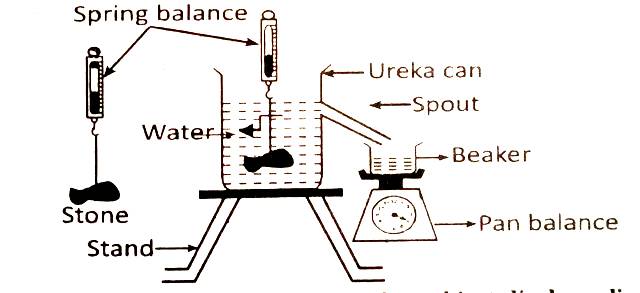If a stone is weighted in air then in water In which condition will it have higher weight? What law be used to verify from the given experiment? What difference will be observed if can is filled with salt water instead of fresh water in which stone is dipped. Give reasons.
1 Answer
According to the given figure, the stone in air will have greater weight as the upthrust of air is not enough to reduce the weight exerted by the object and in B the object is in water. As we know the upthrust of the water is greater the weight of the stone in the water will be less.
From the given experiment Archimedes principle can be verified. If the can is filled with salt water , density of it is more than the fresh water and ultimately upthrust increases. Upthrust is depended on the density of the liquid. This results in increase in the weight of liquid that is displaced out of the can. But the reading in the spring balance decreases. Since, upthrust is directly proportional to the density of liquid.
A body at rest in a fluid is acted upon by a force pushing upward called the buoyant force, which is equal to the weight of the fluid that the body displaces. If the body is completely submerged, the volume of fluid displaced is equal to the volume of the body. If the body is only partially submerged, the volume of the fluid displaced is equal to the volume of the part of the body that is submerged.
Archimedes' principle is very useful for calculating the volume of an object that does not have a regular shape. The oddly shaped object can be submerged, and the volume of the fluid displaced is equal to the volume of the object. It can also be used in calculating the density or specific gravity of an object. For example, for an object denser than water, the object can be weighed in air and then weighed when submerged in water. When the object is submerged, it weighs less because of the buoyant force pushing upward. The object's specific gravity is then the object's weight in air divided by how much weight the object loses when placed in water. But most importantly, the principle describes the behaviour of any body in any fluid, whether it is a ship in water or a balloon in air.


